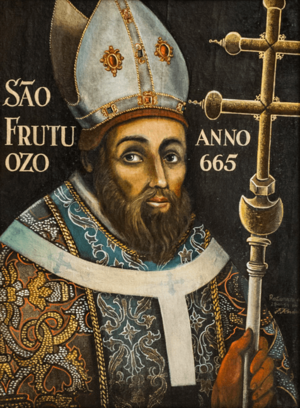Fructuosus of Braga facts for kids
Quick facts for kids SaintFructuosus of Braga |
|
|---|---|

Statue of Fructuosus on a façade of Braga Cathedral
|
|
| Bishop Confessor |
|
| Born | last decade of 6th century or early 7th century El Bierzo or Toledo, Visigothic Kingdom of Hispania |
| Died | 16 April 665 Braga (present-day Portugal) |
| Venerated in | Catholic Church Eastern Orthodox Church |
| Feast | 16 April |
| Attributes | Monk with a stag |
Fructuosus of Braga was an important religious leader who lived a long time ago. He was a bishop and later an archbishop in a place called Braga. He is famous for starting many monasteries, which are places where monks live and pray. He passed away on April 16, 665.
Fructuosus was the son of a powerful leader in the Visigothic Kingdom of Hispania (which is now Spain and Portugal). From a young age, he traveled with his father and saw many places.
Life of Saint Fructuosus
After his parents died, Fructuosus decided to live a simple life. He first learned from a bishop in Palencia. Then, he chose to live alone as a hermit in a quiet desert area in Galicia.
Soon, many students wanted to learn from him. Because so many people gathered, he started his first monastery called Complutum in the El Bierzo region. At first, he led this monastery himself. Later, he chose another leader for it and went back to living alone in the desert.
Over time, Fructuosus founded nine more monasteries. One of these was even for women, led by an abbess named Benedicta.
Founding Monasteries
Some of the monasteries Fructuosus started were in a region called Gallaecia. He also built monasteries further south in the Iberian Peninsula. The exact locations of all these places are not fully known today.
For example, he started Rufiana (also called Monasterium Rufianense) in El Bierzo. He also founded monasteries known as Visoniense and Peonense. Some people think these might be places like San Pedro de Montes or San Fiz de Visoña. He even started a monastery on an island near Cádiz and a nunnery (a monastery for nuns) called Nono.
His monastery at Compludo was known for its very strict rules. Monks there had to tell their leaders all their thoughts, visions, and dreams. They were even checked on during the night. Monks were not allowed to look at each other. The punishments were also very strict, sometimes involving being kept inside the monastery with very little food for several months.
Fructuosus did not always have an easy relationship with the kings of his time. In 652, he wrote to King Recceswinth. He asked the king to release people who had been held in prison for a long time, some since the time of earlier kings.
Becoming a Bishop
Fructuosus later attended an important meeting called the Eighth Council of Toledo in 653. He went in place of another bishop. At this meeting, Fructuosus again spoke up about the political prisoners.
After Bishop Riccimer passed away, Fructuosus took his place as the Bishop of Dumio in 654. In 656, Fructuosus planned a trip to a faraway place called the Levant. However, new laws made it illegal to leave the kingdom without the king's permission. One of his students told the authorities about his plan. Because of this, Fructuosus was arrested and put in prison.
Fructuosus also attended the Tenth Council of Toledo in December 656. At this meeting, people discussed the will of the recently deceased Bishop Riccimer. Riccimer had freed slaves and given church money to the poor. Some people felt this had made the church poor. The council decided that Riccimer had not done his duty properly. They asked Fructuosus to fix the problem, especially concerning the freed slaves. At the same meeting, the Archbishop of Braga was sent to a monastery. Fructuosus was then given his position and became the Archbishop of Braga on December 1, 656.
It is said that Fructuosus dressed so simply that people sometimes thought he was a slave. One story even says a farmer once hit him, thinking he was a slave. He was saved by a miracle.
The story of his life, called a Vita, is a main source for learning about his time. For many years, people thought another person wrote it. But now, it is believed an unknown student of Fructuosus wrote it.
Saint Fructuosus's special day, called his feast day, is celebrated on April 16. His remains were first kept in the Cathedral of Braga. Later, they were moved to a shrine in Santiago de Compostela in 1102. In 1966, they were brought back to Braga. Fructuosus is often shown with a stag (a male deer). This is because he once saved a stag from hunters, and the animal became devoted to him.
Sources
- Thompson, E.A. The Goths in Spain. Clarendon Press: Oxford, 1969.
- Iberian Fathers. Writings of Braulio of Saragossa, Fructuosus of Braga, translated by Claude W. Barlow Catholic University of America Press (1969).
See also
 In Spanish: Fructuoso de Braga para niños
In Spanish: Fructuoso de Braga para niños


